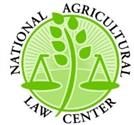As April comes to a close, we bring you another edition of the Ag Law Harvest. This month’s harvest brings you laws and regulations from across the country regarding a national drinking water standard, the Endangered Species Act, Ag-Gag laws, noncompete agreements, and pollution.
EPA Finalizes First-Ever PFAS Drinking Water Standards
Earlier this month, the U.S. Environmental Protection Agency (“EPA”) announced a final rule, issuing the “first-ever national, legally enforceable drinking water standard to protect communities from exposure to harmful per-and polyfluoroalkyl substances (PFAS), also known as ‘forever chemicals’”. The final rule sets legally enforceable maximum contaminant levels for six PFAS chemicals in public water systems. The EPA also announced nearly $1 billion in new funding to “help states and territories implement PFAS testing and treatment at public water systems and to help owners of private wells address PFAS contamination.” The EPA suggests that this final rule “will reduce PFAS exposure for approximately 100 million people, prevent thousands of deaths, and reduce tens of thousands of serious illnesses.”
Interior Deptartment Finalizes Rule to Strengthen Endangered Species Act
The Department of the Interior has announced that the U.S. Fish and Wildlife Service finalized revisions to the Endangered Species Act (ESA). These revisions aim to enhance participation in voluntary conservation programs by promoting native species conservation. They achieve this by clarifying and simplifying permitting processes under Section 10(a) of the ESA, encouraging greater involvement from resource managers and landowners in these voluntary initiatives. For more information about Section 10 of the ESA visit the U.S. Fish and Wildlife Service’s website.
Kentucky Passes Ag-Gag Statute
On April 12, 2024, the Kentucky legislature overrode the governor’s veto to pass Senate Bill 16 into law. The new law, titled “An Act Relating to Agricultural Key Infrastructure Assets,” expands the definition of “key infrastructure assets” to include commercial food manufacturing or processing facilities, animal feeding operations, and concentrated animal feeding operations. It criminalizes trespassing on such properties with unmanned aircraft systems, recording devices, or photography equipment without the owner’s consent. The first offense is a Class B misdemeanor with up to 90 days imprisonment and a $250 fine, while subsequent offenses are Class A misdemeanors with up to 12 months imprisonment and a $500 fine.
Federal Trade Commission Bans Non-Compete Agreements
The Federal Trade Commission (“FTC”) announced a final rule banning noncompete agreements and clauses nationwide. This move aims to promote competition by safeguarding workers’ freedom to change jobs, increasing innovation and the formation of new businesses. Under the FTC’s new rule, existing noncompetes for the vast majority of workers will no longer be enforceable after the rule’s effective date. However, existing noncompetes for senior executives – those earning more than $151,164 annually and in policy making positions – remain enforceable under the new rule. Employers will have to notify workers bound to an existing noncompete that the noncompete agreement will not be enforced against the worker in the future. The final rule will become effective 120 days after publication in the Federal Register.
EPA Announces New Rules to Reduce Pollution from Fossil Fuel-Fired Power Plants
The U.S. Environmental Protection Agency (“EPA”) unveiled a set of final rules designed to decrease pollution from fossil fuel-fired power plants. These rules, developed under various laws such as the Clean Air Act, Clean Water Act, and Resource Conservation and Recovery Act, aim to protect communities from pollution and improve public health while maintaining reliable electricity supply. They are expected to substantially reduce climate, air, water, and land pollution from the power industry, aligning with the Biden-Harris Administration’s goals of promoting public health, advancing environmental justice, and addressing climate change.



